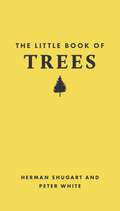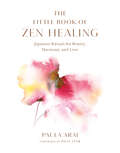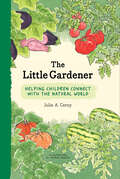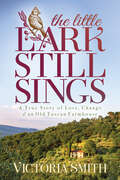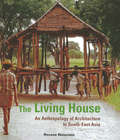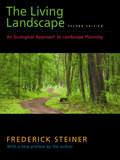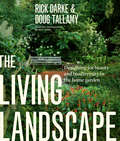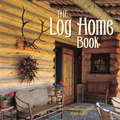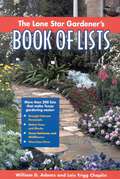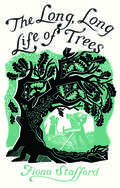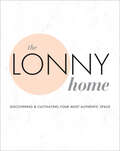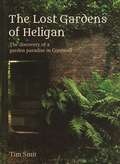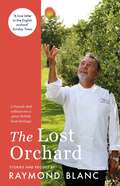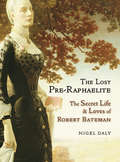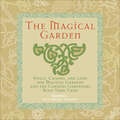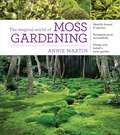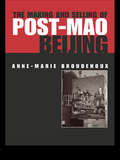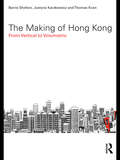- Table View
- List View
The Little Book of Natural Cleaning
by SphereHome is where the heart is... Home is the place where everyone should feel happy and at peace . . . and that means a house that is clean, safe and welcoming to all.Using traditional, natural cleaning methods to tackle everyday chores is not only a simple and effective way to help the environment, but also helps safeguard your family, friends and pets from germs and the potentially harmful side-effects of many modern cleaning products.THE LITTLE BOOK OF NATURAL CLEANING contains everything you need to know about cleaning with easy-to-find and inexpensive natural ingredients like lemons, bicarbonate of soda and white vinegar. Your home will soon be fresh, clean and safe for all the family.And whilst you #StayHome, don't miss these other great titles from Sphere Books: ** Distract Yourself: 101 Positive Things to Do and Learn Whilst You Stay Home **** The Bumper Book of Would You Rather? Over 350 hilarious hypothetical questions for ages 6 to 106 **** AA British Road Map Puzzle Book: Addictive map-based brain-games for anyone in lockdown ** ** Shelf Respect: A Book Lovers' Guide to Curating Book Shelves at Home **
The Little Book of Natural Cleaning (Home Sweet Home)
by The Little Book of Natural CleaningHome is where the heart is... Home is the place where everyone should feel happy and at peace . . . and that means a house that is clean, safe and welcoming to all.Using traditional, natural cleaning methods to tackle everyday chores is not only a simple and effective way to help the environment, but also helps safeguard your family, friends and pets from germs and the potentially harmful side-effects of many modern cleaning products.THE LITTLE BOOK OF NATURAL CLEANING contains everything you need to know about cleaning with easy-to-find and inexpensive natural ingredients like lemons, bicarbonate of soda and white vinegar. Your home will soon be fresh, clean and safe for all the family.And whilst you #StayHome, don't miss these other great titles from Sphere Books: ** Distract Yourself: 101 Positive Things to Do and Learn Whilst You Stay Home ** ** The Bumper Book of Would You Rather? Over 350 hilarious hypothetical questions for ages 6 to 106 **** AA British Road Map Puzzle Book: Addictive map-based brain-games for anyone in lockdown ** ** Shelf Respect: A Book Lovers' Guide to Curating Book Shelves at Home **
The Little Book of Trees (Little Books of Nature #4)
by Peter White Herman ShugartA charming, richly illustrated, pocket-size exploration of the world&’s treesPacked with surprising facts, this delightful and gorgeously designed book will beguile any nature lover. Expertly written and beautifully illustrated throughout with color photographs and original color artwork, The Little Book of Trees is an accessible and enjoyable mini reference about the world&’s trees, with examples drawn from across the globe. It fits an astonishing amount of information in a small package, covering a wide range of topics—from tree anatomy, diversity, and architecture to habitat and conservation. It also includes curious facts and a section on trees in myths, folklore, and modern culture from around the world. The result is an irresistible guide to the amazing lives of trees.A beautifully designed pocket-size book with a foil-stamped cloth coverFeatures some 140 color illustrations and photosMakes a perfect gift
The Little Book of Zen Healing: Japanese Rituals for Beauty, Harmony, and Love
by Paula AraiAccessible and adaptable Japanese Buddhist rituals to infuse your life with purpose, healing, and gratitude when you need it most.How do we make and sustain meaning amidst the messy conditions of daily life? Personalized rituals can help us blossom like lotuses right in the mud of the present. On a pilgrimage she began after her mother&’s death, author Paula Arai encountered numerous Japanese Buddhists who taught her the remarkable power of ritual to heal—practices you can adapt to your own cultural and personal circumstances. Applying principles of Zen practice, she offers stories and insights that illuminate how to nourish and reap a healing bounty of connection, joy, and compassion. Examples include how to: Relate to a late loved one as a &“personal Buddha&” who supports you Create a home altar to serve as a safe space to be vulnerable, face intense emotions, and experience a depth of warm gratitude that melts fear and anger Engage in daily tasks with attentiveness, intention, and creativity such that they become opportunities for body-mind integration Develop family rituals to celebrate relationship and mark transition Approach illness and grief with a purposeful sense of connection to life-and-death in its wholeness Like Marie Kondo's Shinto principles for decluttering, Paula Arai uses rituals influenced by Japanese Zen for personal and relation nourishment and spiritual healing.
The Little Gardener: Inspire Children to Connect with the Natural World
by Julie CernyThe Little Gardener is an engaging illustrated guide for parents, grandparents, caregivers, and educators who want to help children explore the natural world through gardening. Part how–to, part teaching tool, and part inspiration, The Little Gardener is a thoughtful combination of detailed instructions, tips, anecdotes, and seasonal activities designed to connect gardeners to natural systems. With fun projects, useful charts, and creative journal prompts, The Little Gardener shows gardeners of all ages how to envision and build their garden together by making the process an adventure to be treasured, with much to learn along the way.
The Little Lark Still Sings: A True Story of Love, Change & an Old Tuscan Farmhouse
by Victoria SmithIn this memoir of life abroad, a married couple discovers the charms and challenges of Italy when they buy their Tuscan dream home.Happily married for two decades, Victoria and Larry decide to move to their favorite hilltown in Tuscany. But what begins as a romantic adventure soon becomes a drama of change and perseverance. Alongside Italy’s wonders—its beauty, art, architecture, food, and history—come the challenges of daily life in a foreign culture, surviving the chaos of construction, navigating narrow roads, longing for friends, stumbling with language, and so much more. As these struggles undermine Victoria’s confidence which, in turn, wears on Larry’s patience.Though they share a dream, they discover their personal goals are different. His are to study and write, hers are to create the perfect Italian home and make friends. He needs quiet time; she needs his help. From the joys and near disasters of renovating an ancient stone farmhouse to celebrating their first Italian dinner party, Victoria learns about Italy, herself, and their marriage. In The Little Lark Still Sings, she shares their humorous and character-stretching experiences with uplifting insight and wisdom.
The Living House
by Roxana WatersonThe Living House was the first book of its kind to present a detailed picture of the house within the social and symbolic worlds of Southeast Asian peoples. A pioneering title that has become a classic, this exemplary text draws on many sources of information, from architects and anthropologists, to the author's own firsthand research.As it probes into the centrally significant role of houses within Southeast Asian social systems, The Living House reveals new insights into kinship systems, gender symbolism and cosmological ideas, ultimately uncovering basic themes concerning the idea of life and life processes themselves. A vivid picture emerges of how people shape buildings and buildings shape people, as rules about layout and uses of space have an impact on social relationships.Although intended first and foremost as a work of anthropology, The Living House will also appeal to architects, scholars and the interested general reader.
The Living Landscape, Second Edition: An Ecological Approach to Landscape Planning
by Frederick R. SteinerThe Living Landscape is a manifesto, resource, and textbook for architects, landscape architects, environmental planners, students, and others involved in creating human communities. Since its first edition, published in 1990, it has taught its readers how to develop new built environments while conserving natural resources. No other book presents such a comprehensive approach to planning that is rooted in ecology and design. And no other book offers a similar step-by-step method for planning with an emphasis on sustainable development. This second edition of The Living Landscape offers Frederick Steiner's design-oriented ecological methods to a new generation of students and professionals. The Living Landscape offers * a systematic, highly practical approach to landscape planning that maximizes ecological objectives, community service, and citizen participation * more than 20 challenging case studies that demonstrate how problems were met and overcome, from rural America to large cities * scores of checklists and step-by-step guides * hands-on help with practical zoning, land use, and regulatory issues * coverage of major advances in GIS technology and global sustainability standards * more than 150 illustrations. As Steiner emphasizes throughout this book, all of us have a responsibility to the Earth and to our fellow residents on this planet to plan with vision. We are merely visiting this planet, he notes; we should leave good impressions.
The Living Landscape: Designing for Beauty and Biodiversity in the Home Garden
by Douglas W. Tallamy Rick DarkeMany gardeners today want a home landscape that nourishes and fosters wildlife. But they also want beauty, a space for the kids to play, privacy, and maybe even a vegetable patch. Sure, it’s a tall order, but The Living Landscape shows how to do it. By combining the insights of two outstanding authors, it offers a model that anyone can follow. Inspired by its examples, you’ll learn the strategies for making and maintaining a diverse, layered landscape—one that offers beauty on many levels, provides outdoor rooms and turf areas for children and pets, incorporates fragrance and edible plants, and provides cover, shelter, and sustenance for wildlife. Richly illustrated with superb photographs and informed by both a keen eye for design and an understanding of how healthy ecologies work, The Living Landscape will enable you to create a garden that is full of life and that fulfills both human needs and the needs of wildlife communities.
The Locavore Way: Discover And Enjoy The Pleasures Of Locally Grown Food
by Amy CotlerEating food grown close to home is not only tasty, but comes with great benefits for the health of your family, your local community, and the environment. Learn how and where to find local foods, how to eat locally on a tight budget, what questions to ask at the farmers’ market, and how to grow your own food in small spaces. With shopping tips and simple guides to preparing what’s in season, The Locavore Way makes eating locally as simple as it is delicious.
The Log Home Book
by Ralph KylloeRoom-by-room inspiration for the affordable mountain retreat of your dreams, from the author of Rustic Elegance and Ralph Kylloe&’s Rustic Living. A foremost authority on rustic design and furnishings, Ralph Kylloe chose for this book his most inspiring images from twenty years of photographing mountain retreats across America. Richly layered images of living rooms, kitchens, dining rooms, bedrooms, bathrooms, and recreation rooms are a springboard for cabin planning and vacation dreaming.
The Log Home Maintenance Guide: A Field Guide for Identifying, Preventing, and Solving Problems
by Gary SchroederPreventing problems and dealing with them when they occur. America has hundreds of thousands of log homes, and every one of them presents unique maintenance issues that differ from homes of traditional stick-frame construction. Lack of knowledge about the unique characteristics of a log home all too often results in owners inadvertently doing damage when they try to make repairs. Owners of log homes have long relied on the expertise of log home builder and specialist Gary Schroeder and his Schroeder Log Home Supply company, a trusted source of information and guidance. From dry rot to carpenter ants, Schroeder has seen it all. Now he shares his wisdom on how to preserve and protect your beautiful log home. This newly revised edition takes advantage of all the recent techniques and products--it's a state-of-the-art guide to identifying, diagnosing, and solving problems so you'll enjoy many trouble-free years in your log home. Gary Schroeder, a former forester and consultant, has also been a custom log home builder and restoration contractor. He and his wife, Kathy, started Schroeder Log Home Supply, Inc., now a leader in the field, in 1986.
The Lone Star Gardener's Book of Lists
by William D. Adams Lois Trigg ChaplinWith more than 200 lists of plants and garden resources, this guide has the answers on what to plant where and on how to handle the toughest of Texas conditions. William D. Adams and Lois Trigg Chaplin offer numerous recommendations, noting the best growing zones and bringing together helpful hints and information from dozens of gardeners, nurseries, and horticultural professionals across the state.
The Long, Long Life of Trees
by Fiona StaffordA lyrical tribute to the diversity of trees, their physical beauty, their special characteristics and uses, and their ever-evolving meanings Since the beginnings of history trees have served humankind in countless useful ways, but our relationship with trees has many dimensions beyond mere practicality. Trees are so entwined with human experience that diverse species have inspired their own stories, myths, songs, poems, paintings, and spiritual meanings. Some have achieved status as religious, cultural, or national symbols. In this beautifully illustrated volume Fiona Stafford offers intimate, detailed explorations of seventeen common trees, from ash and apple to pine, oak, cypress, and willow. The author also pays homage to particular trees, such as the fabled Ankerwyke Yew, under which Henry VIII courted Anne Boleyn, and the spectacular cherry trees of Washington, D. C. Stafford discusses practical uses of wood past and present, tree diseases and environmental threats, and trees' potential contributions toward slowing global climate change. Brimming with unusual topics and intriguing facts, this book celebrates trees and their long, long lives as our inspiring and beloved natural companions.
The Lonny Home: Discovering & Cultivating Your Authentic Space
by Lonny Magazine Sean SantiagoLearn how to find your personal interior design style and set up your space to match with this guide from the lifestyle and home décor magazine.Lonny Magazine is the ultimate online destination for interiors inspiration. With chapters that help you meditate on your space, go on a home cleanse, find unique decor pieces that speak to you, transform raw inspiration into actual design solutions, and continue to grow your space over time, The Lonny Home is a beautiful book that demystifies stylish living, as well as encourages you to cultivate home habits that give your happiness and health a boost.Peppered with house tours of real-life homeowners and advice from celebrated experts in diverse walks of life, The Lonny Home will provide you with hands-on information for solving some of our homes’ most common problems—like lack of light and all that clutter—as well as fun ways to brighten your space with tabletop vignettes, shelfies, gallery walls, and more. With sage text penned by stylist and influencer Sean Santiago, you’ll learn how to re-envision your environment so it survives the trends and becomes an attractive sanctuary—no matter your personal style and where you are in your life.Brimming with charming illustrations and exquisite interiors photography (both freshly commissioned and from the magazine’s vault), The Lonny Home is more than a book of the latest decor ideas—it is a journey in how your home can better reflect and support you in all that you do, and an art object you’ll want to give a permanent place on your coffee table as decor itself.
The Lost Gardens Of Heligan
by Tim SmitThe glorious No.1 bestsellerUntil the First World War, the estate gardens at Heligan were one of the glories of Cornwall. Thereafter, through growing neglect, they slipped gradually to sleep. This is the amazing story of their rediscovery and restoration, or the Victorian vision and ingenuity which first created that subtropical paradise, and of the modern obsession and improvisation which recreated it.
The Lost Gardens Of Heligan: A Portrait Of The Lost Gardens
by Tim SmitThe glorious No.1 bestsellerUntil the First World War, the estate gardens at Heligan were one of the glories of Cornwall. Thereafter, through growing neglect, they slipped gradually to sleep. This is the amazing story of their rediscovery and restoration, or the Victorian vision and ingenuity which first created that subtropical paradise, and of the modern obsession and improvisation which recreated it.
The Lost Orchard: A French chef rediscovers a great British food heritage
by Raymond Blanc'Blanc set about the most thorough apple-tasting and cooking project I have heard of . . . [The Lost Orchard] condenses the highlights, his love letters to the forgotten apple breeds.' The Times'I began to dream about an orchard filled with thousands of fruit trees... Today we have an orchard with over 150 ancient varieties of apple. Each one has its heritage in a village or a county that used to thrive on that particular variety. They tell the story not only of what we have lost in Britain but also what we could regain.'Over the past seven years, Raymond Blanc has planted an orchard of 2,500 trees in the grounds of his hotel-restaurant in Oxfordshire. Yielding about 30 tonnes of fruit for his kitchen each year, it is full of ancient and forgotten varieties of British apples and pears, along with walnut trees, quince, medlars, apricots, nectarines, peaches, plums, damsons and cherries. A further 600 heritage fruit trees have been added from Raymond's home region of Franche-Comté in France. The Lost Orchard is a love letter to each of these varieties, complete with beautiful black and white drawings, photographs of Belmond Le Manoir and fascinating information and anecdotes about each fruit, along with recipes and stories.
The Lost Orchard: A French chef rediscovers a great British food heritage
by Raymond Blanc'Blanc set about the most thorough apple-tasting and cooking project I have heard of . . . [The Lost Orchard] condenses the highlights, his love letters to the forgotten apple breeds.' The Times'I began to dream about an orchard filled with thousands of fruit trees... Today we have an orchard with over 150 ancient varieties of apple. Each one has its heritage in a village or a county that used to thrive on that particular variety. They tell the story not only of what we have lost in Britain but also what we could regain.'Over the past seven years, Raymond Blanc has planted an orchard of 2,500 trees in the grounds of his hotel-restaurant in Oxfordshire. Yielding about 30 tonnes of fruit for his kitchen each year, it is full of ancient and forgotten varieties of British apples and pears, along with walnut trees, quince, medlars, apricots, nectarines, peaches, plums, damsons and cherries. A further 600 heritage fruit trees have been added from Raymond's home region of Franche-Comté in France. The Lost Orchard is a love letter to each of these varieties, complete with beautiful black and white drawings, photographs of Belmond Le Manoir and fascinating information and anecdotes about each fruit, along with recipes and stories.
The Lost Pre-Raphaelite
by Nigel DalyWhen the author bought a falling down fortified house on the Staffordshire moorlands, he had no reason to anticipate the astonishing tale that would unfold as it was restored. A mysterious set of relationships emerged amongst its former owners, revolving round the almost forgotten artist, Robert Bateman, a prominent Pre-Raphaelite and friend of Burne Jones. He was to marry the granddaughter of the Earl of Carlisle, and to be associated with Benjamin Disraeli, William Gladstone, and other prominent political and artistic figures.But he had abandoned his life as an artist in mid-career to live as a recluse, and his rich and glamorous wife-to-be had married the local vicar, already in his sixties and shortly to die. The discovery of two clearly autobiographical paintings led to an utterly absorbing forensic investigation into Bateman's life.The story moves from Staffordshire to Lahore, to Canada, Wyoming, and then, via Buffalo Bill, to Peru and back to England. It leads to the improbable respectability of Imperial Tobacco in Bristol, and then, less respectably, to a car park in Stoke-on-Trent. En route the author pieces together an astonishing and deeply moving story of love and loss, of art and politics, of morality and hypocrisy, of family secrets concealed but never quite completely obscured. The result is a page-turning combination of detective story and tale of human frailty, endeavor, and love. It is also a portrait of a significant artist, a reassessment of whose work is long overdue.Nigel Daly is an antique dealer and house restorer.
The Ludic City: Exploring the Potential of Public Spaces
by Quentin StevensThis international and illustrated work challenges current writings focussing on the problems of urban public space to present a more nuanced and dialectical conception of urban life. Detailed and extensive international urban case studies show how urban open spaces are used for play, which is defined and discussed using Caillois' four-part definition – competition, chance, simulation and vertigo. Stevens explores and analyzes these case studies according to locations where play has been observed: paths, intersections, thresholds, boundaries and props. Applicable to a wide-range of countries and city forms, The Ludic City is a fascinating and stimulating read for all who are involved or interested in the design of urban spaces.
The Magical Garden: Spells, Charms, and Lore for Magical Gardens and the Curious Gardeners Who Tend Them
by Denny Sargent Sophia SargentThe Magical Garden is a curious little book of magic, charms, spells, and bits of traditional and historical lore from and for magical gardens and the curious gardeners who tend to them. What gardener would not want to know the flower they were born under, the traditional magical meanings of bells and chimes, or the healing power of geraniums? Many of these nuggets of wisdom and magic have been handed down from Sophia's grandparents, who extensively used herbs and such in their psychic work. Avid gardener and ancient historian Denny Sargent collected much of the information included here from a wide variety of traditional sources. Roman, Celt, Norse, and Japanese gardeners all believed in garden magic, and some of their most fascinating traditions, spells, and charms are contained in this wonderful little book. In addition to the garden, magical plants, birds, insects, the yard, and the weather are also addressed. Other interesting lore includes: Garden sprites, fairies, and elves; Ancient and magical ways for empowering the garden by planting certain plants in special places; Traditions for celebrating festivals in the garden, ways of using garden plants for protection, and techniques for invoking positive energy with trees.
The Magical World of Moss Gardening
by Annie Martin“This is a fascinating books for anyone wanting to truly broaden the range of plants they grow.” —Gardens Illustrated Moss is an extraordinary plant—it grows without roots, flowers, or stems. Despite being overlooked, in many ways, moss is perfect: it provides year-round color, excels in difficult climates, prevents soil erosion, and resists pests and disease. In The Magical World of Moss Gardening, bryophyte expert Annie Martin reveals how moss can be used in stunning, eco-friendly spaces. The beautifully illustrated guide includes basics on designing and planting a moss garden, as an inspiring tour of the most magical public and private moss gardens throughout the country.
The Making and Selling of Post-Mao Beijing (Planning, History and Environment Series)
by Anne-Marie BroudehouxDescribes the changing life of the city and its inhabitants during the final decades of the twentieth century and examines the complex forces at play in the search for modernity. The author presents us with four case studies of how the city is marketing and selling itself (including its refurbishment for the 2008 Olympic bid) and concludes that Beijing's urban image construction may provide an avenue for opposition groups to challenge the hegemony of those in power.
The Making of Hong Kong: From Vertical to Volumetric (Planning, History and Environment Series)
by Thomas Kvan Justyna Karakiewicz Barrie SheltonThis book investigates what the history of Hong Kong’s urban development has to teach other cities as they face environmental challenges, social and demographic change and the need for new models of dense urbanism. The authors describe how the high-rise intensity of Hong Kong came about; how the forest of towers are in fact vertical culs de sac; and how the city might become truly ‘volumetric’ with mixed activities through multiple levels and 3D movement networks incorporating ‘town cubes’ rather than town squares. For more information, visit the authors' website: http://www.makingofhk.com/makingofhk.swf

